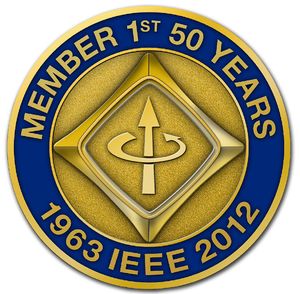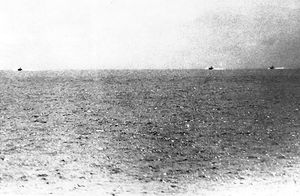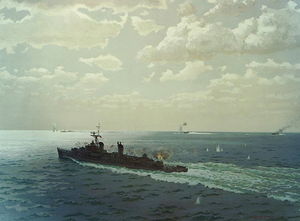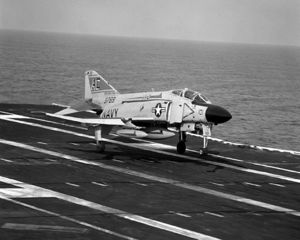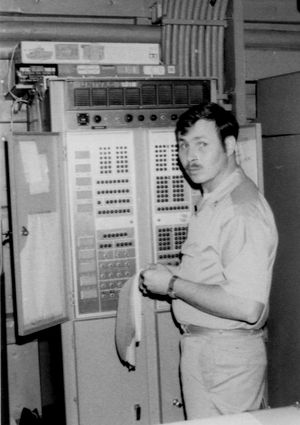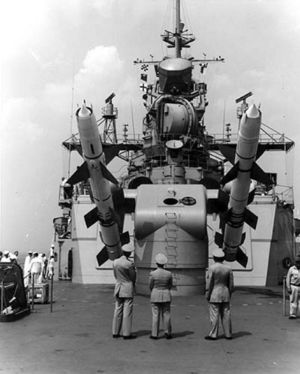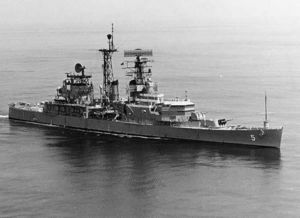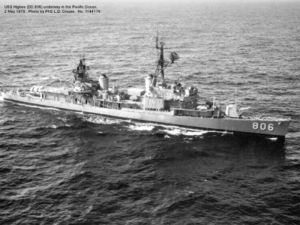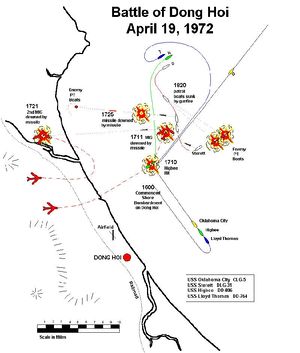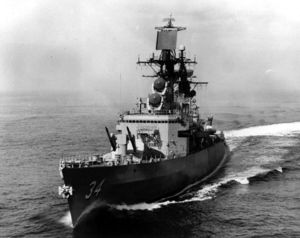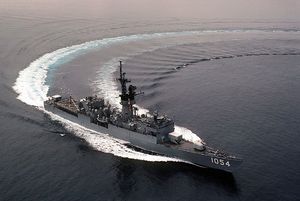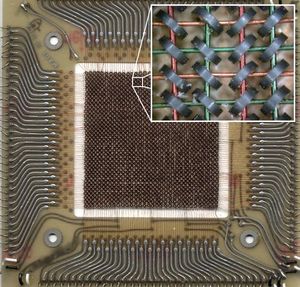First-Hand:The Naval Tactical Data System in Combat - Chapter 7 of the Story of the Naval Tactical Data System
By David L. Boslaugh, Capt. USN, Retired
Vietnam, the Real Service Test
It was mid afternoon on Sunday August 2, 1964, and the United States destroyer Maddox was on a mission to monitor military shore activities near the Red River delta off the coast of North Vietnam. The ship was commanded by Commander Herbert L. Ogier, and the senior officer on board was Captain. John J. Herrick, Commander Destroyer Division 192. Cdr. Ogier was keeping his ship at least eight miles off the coast while his team of U. S. Naval Security Group language specialists listened in on North Vietnamese military radio traffic.
Even though Capt. Herrick was confident the ship was in international waters, he observed, a little before 3 PM, three North Vietnamese fast motor torpedo boats emerge from behind Hon Me Island and head straight for Maddox. Prudently, Capt. Herrick ordered Ogier to head the ship out to sea, but the patrol boats persisted and gained on him rapidly. The ship went to general quarters and Herrick told the skipper to engage the boats with his six five-inch guns if they closed within ten thousand yards.
A little after 3 PM Maddox opened fire on the torpedo boats, and at the same time put out a radio request for air support from the nearby aircraft carrier Ticonderoga. The boats were not deterred by the gunfire and proceeded closer firing their 14.5 millimeter machine guns. At about five thousand yards two of the boats launched torpedoes. Maddox turned hard to avoid the torpedoes, and at the same time scored hits on all three boats. Heading directly for the destroyer, the third boat loosed its torpedo which did not get engine start., and about the same time three Chance Vought “Crusader” fighter jets from Ticonderoga arrived to strafe the boats. The end result was one boat dead in the water burning and the other two limping for home. Maddox had one machine gun round lodged in the pedestal of her after five-inch gun director.
Two days later on the night of 4 August while patrolling Tonkin Gulf waters, radar operators in Maddox and a companion destroyer Turner Joy thought they detected more oncoming torpedo boats in the surrounding blackness. Weather conditions were sometimes making a wave crest look like a radar target, but no one could be sure. The two ships went to general quarters and had a two-hour running gun battle with their suspected opponents whom they could not see, but who seemed to be popping up on their radar scopes. (Once they started firing, their own shell splashes reflected back by their radars probably gave them many indications of targets in the direction of the splashes.) One of the sonar operators thought he heard torpedoes running a number of times.
A few weeks later, thorough investigation revealed that there had been no attacking North Vietnamese torpedo boats that night, but at the time many, from sailors in the ‘engagement’ on up to the President of the United States, were convinced that the the North Vietnamese had again attacked American naval units. In a few days Congress passed the Tonkin Gulf Resolution, and the United States was soon at war with North Vietnam. [Karnow, Stanley, Vietnam - A History - the First Complete Account of Vietnam at War, The Viking Press, New York, 1983, ISBN 0-670-74604-5, pp 366-75]
On PIRAZ
What is PIRAZ?
Aside from some limited attacks made by carrier airplanes on North Vietnamese patrol boat facilities and fuel storage sites, President Lyndon Johnson was hesitant to authorize large scale retaliatory airborne attack on targets in North Vietnam. That is until a series of escalations in hostilities convinced him to authorize U.S. air raids on North Vietnam, under the code phrase Operation Flaming Dart, on 7 February 1965. Then on 24 February large scale sustained bombing of North Vietnam began under the code phrase: Operation Rolling Thunder. [Karnow, p 682] The American attack carriers of Task Force participating in Rolling Thunder began operations from a location in the Gulf of Tonkin which they called ‘Yankee Station.’ Initially Yankee Station was located about 400 miles off the coast of North Vietnam, in part to keep the carriers beyond the range of North Vietnamese aircraft. This distance required long over-water flights, often needing mid air refueling, and greatly restricted the number of sorties flown per day. To get the needed number of sorties called for as many as six attack carriers on station at one time, an unacceptable drain on resources.
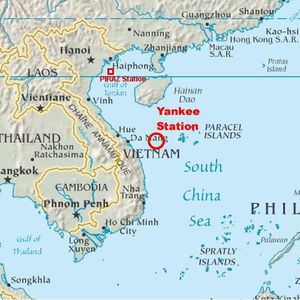
The solution was to move Yankee Station closer to the intended targets, meaning the station would usually be about 150 miles offshore. [Nichols, Cdr. John B., Tillman, Barrett, On Yankee Station, The Naval Air War Over Vietnam, United States Naval Institute, Annapolis, MD, 1978 ISBN 0-87021-559-0, p 19] The new location, made put the carriers vulnerable to air attack, and it became very important to the task force commander to have a clear picture of air activity in the Gulf of Tonkin, particularly to know if there were any hostiles mixed in with the friendly air traffic. The first step was to set up a ‘radar advisory zone” meaning devising a way of keeping track of all known friendly and neutral air traffic in the area. If the task force could be positive about these identifications, than any other aircraft detected on radar could be assumed hostile. This does not mean that an assumed hostile airplane would be immediately engaged by surface-to-air missiles (unless he posed a clear and immediate threat) but would soon be visited by an airborne interceptor (combat air patrol) who would make an identification.
The air defense concept was called Positive Identification Radar Advisory Zone (PIRAZ), and called for stationing ships about 30 miles off the mainland so that they could get radar coverage of the air space over North Vietnam. The station would be between the intended land targets and the attack carriers to monitor and keep track of all air traffic in the PIRAZ area. In addition to being armed with surface-to-air missile systems, always at the ready, the PIRAZ ships would be under the protective umbrella of the carrier’s combat air patrols around the clock, and could call in an interceptor at any time. Also, because of the possibility of North Vietnamese torpedo boats in an area so close to the mainland, each PIRAZ ship would have an accompanying destroyer , designated ‘shotgun’ as a protection against motor torpedo boats. [“PIRAZ” From Wikipedia, the Free Encyclopedia]
Under the PIRAZ concept, as early as 12 to 18 hours before a planned sortie all Navy, Air Force, South Vietnamese and Marine Corps activities were to pass to the PIRAZ ship their intended flight plans for all aircraft that would enter the PIRAZ zone. An important part of this work was close coordination of strike information with the Air Force reporting center at Da Nang, South Vietnam. This information was to be recorded and displayed on the ship in a way that would be immediately accessible to combat information center operators, and the involved aircraft were to check in and identify themselves when entering the zone and check out when leaving. In the mean time on a 24/7 basis, the CIC operators would track, monitor, control, and assist the airplanes as needed. [Lockee, Capt. Garette E. USN, “PIRAZ”, U.S. Naval Institute Proceedings, Apr. 1969, pp 143-146]
In the above referenced article on PIRAZ, Capt. Lockee lists nine specific functions expected of the PIRAZ CIC team, these were:
Air Control - of two kinds: advisory control and close control. Advisory control means the shipboard air controller sets an area or limits within which the aircraft can fly, after which the controller monitors the plane’s location and advises if the the pilot has strayed out of the boundaries. Advisory control was used for combat air patrol fighters, airborne tankers, and airborne early warning aircraft. Close control has the PIRAZ air controller sending spcific speed, heading and altitude orders such as to an interceptor tasked with identifying a stray, or shooting down a hostile.
Provide Assistance - including vectoring airborne tankers under close control to strike aircraft low on fuel, vectoring search and rescue aircraft to the position of downed airmen, relaying information from strike pilots back to their carriers, and providing numerous kinds of operational information to pilots such as weather reports, locations of other units, and directions back to their carriers.
Hostile Aircraft Warnings - advising pilots of the locations of unidentified or hostile aircraft that might be a threat to friendly aircraft.
Border Warnings - when friendly aircraft were approaching the border of Communist China or the Chinese island of Hainan.
Identify Hostiles and Destroy - with missiles or interceptors under close control, any hostile considered a direct threat to the PIRAZ ship or nearby friendly aircraft.
Barrier Combat Air Patrol - stationing and controlling combat air patrol interceptors.
Flight Following - including tracking and communicating with each strike force from a Yankee Station attack carrier; with one flight follower on the PIRAZ ship assigned to each strike force. It was the duty of the flight follower to positively identify each airplane in the attacking formation and maintain a track on it into the target and back out again to its carrier. On the way out the flight follower had to closely screen the formation to detect any hostiles that might be trying to pose as part of the formation.
Prosecute or Assist in Search and Rescue Missions - to find and rescue downed pilots. The operators would monitor voice and identification-friend-or-foe (IFF) transmissions from the strike aircraft listening and looking for distress calls or signs. Any plane in distress was closely watched, and if it went down the PIRAZ operators would enter the last known location into NTDS so that rescue helicopters waiting at the raid exit point could be quickly vectored to the crash site. Most of the PIRAZ ships also carried search and rescue helicopters, and were credited with saving many pilot’s lives, or preventing their captivity.
Relay of Surface To Air Missile Warnings - of potential hostile surface missile activity to friendly aircraft when the PIRAZ ship’s electronic countermeasures operators detect radio emanations from hostile surface to air missile systems.
Capt. Lockee concludes his article with the statement, “Accomplishment of the PIRAZ tasks stresses a ship, its equipment, and its personnel like no other cruiser-dsestroyer assignment of the past. PIRAZ is a most challenging undertaking.”
NTDS Ships are the Only Ones That Can Do It
To get an idea of the dimensions of the PIRAZ job, the controlled area covered about 50 thousand square miles, and the average air traffic at any one time was about 100 aircraft; including not only military planes, but also commercial flights. It was described as far busier than the airspace around the most congested commercial airports. [Lockee, pp 143-46] Sometimes during carrier air strikes the number of aircraft in the zone would rise to more than three hundred. Normally there would be three attack carriers on Yankee Station and they launched strikes daily. The first raid of the day would usually check in with the PIRAZ ship at just about sunrise. [Meyer, Radm. Wayne E. USN, “The Combat Systems of Warships,” U. S. Naval Institute Proceedings, Vol 103, No. 891, May 1977, p 116] [Brown, Cdr. Nicholas, USN, “The Changing Role of the Officer of the Deck” U. S. Naval Institute Proceedings, Vol 98, No. 9/835, Sep. 1972, p 112]
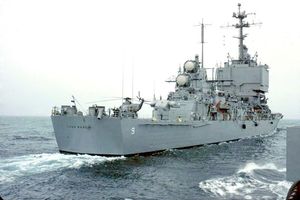
Because the PIRAZ ships operated only about 30 miles off the coast od North Vietnam they has to have missile systems for their own self defense, and they had to have a big combat information center. At the beginning it was thought that the World War II cruisers that had been converted to guided missile cruisers would be best for the job. The first few that tried, with their WW II style manual plotting and status boards were overwhelmed, they could not handle the job. It was not until the converted cruiser USS Chicago, with her newly installed Naval Tactical Data System showed up on the PIRAZ station on 15 June 1966 that PIRAZ was mastered. After that, only NTDS equipped ships would be assigned to PIRAZ The NTDS service test ship USS King would be one of the next to complete the job and it would be relieved by the missile Cruiser Long Beach, also carrying her service test NTDS. After that every NTDS equipped cruiser and guided missile frigate would successfully take on the PIRAZ mission. They were the only ones that could. [U. S. Naval History Center, On Line Dictionary of American Naval Fighting Ships, www.history.navy.mil]
The Beacon Video Processor
In the last half of the 1960s one aspect of the Naval Tactical Data System was still not automated; that is target track coordinates still had to be manually entered from radar consoles into the computer. As has already been mentioned the number of air targets in the PIRAZ area averaged more than a hundred and sometimes exceeded three hundred. During times of such high activity there would be more than one PIRAZ ship stationed in the northwest corner of the Gulf of Tonkin; some times as many as five, and there would always be at least one airborne early warning aircraft, equipped with a flying version of NTDS, in the air over the Gulf (We will review the airborne tactical data system (ATDS) in a following chapter). With the NTDS tactical data link the PIRAZ ships and the ATDS airplane could thereby share the tracing load.
There were normally six NTDS tracking operators in a guided missile frigate (including the tracking supervisor), and a single tracker, in sustained operations, could usually handle no more than five tracks simultaneously with good accuracy. This means a single frigate could not process well more than 30 tracks at a time, and that five frigates and an ATDS aircraft would be doing well if they could handle 200 tracks by sharing the tracking load. Track entry and updating was a very demanding load on the tracking operators, and even worse, during periods of heaviest load the tracking operators did not have enough time to look intently for new tracks, especially hostiles, or for IFF beacon signals from friendly aircraft in distress.
Ironically there was a device right at the tracking operators fingertips that could automatically show on their radar scopes the range, bearing, and sometimes even altitude, of every friendly aircraft within range of their radar. This was the identification-friend-or-foe (IFF) system built into their radars. By simply pressing a button as the radar beam swept a target the operator could send out a coded radio signal to ‘interrogate’ the aircraft under question. If the aircraft was a friendly, it would be equipped with an IFF transponder that recognized the coded transmission and in turn would respond with a coded, all directions, beacon signal, that would tell the shipboard IFF receiver ‘yes I am a friendly aircraft.’
The IFF receiver would know the aircraft bearing as being the same as the radar antenna’s bearing, and would know the aircraft range by measuring the time difference from transmission of the coded pulse to its receipt back at the ship. If the airplane were so equipped, the plane’s altitude would also be fed into its IFF transponder, and part of the coded response to the interrogation would include altitude. The shipboard IFF receiver would decode the response, and if the aircraft transponder had the correct ‘code of the day’ set into it, the receiver would cause a distinctive symbol to be displayed on the operator’s radar display at the range and bearing of the interrogated airplane - telling the operator the airplane was friendly.
The shipboard operators reckoned, “If my IFF receiver knows the range and bearing of every friendly airplane I interrogate, wouldn’t it be nice if it could send that same information directly to the NTDS computer as well as showing it on my radar scope. Then if it automatically interrogated every airplane, I would not have to do track entries and updates on friendly airplanes; and - most of the airplanes out there are friendlies.”
In the summer of 1966 some of the skippers of PIRAZ ships were sending messages up their chain of command that they needed a way of automatically entering air target track information from their IFF system into the NTDS computer. In response, Office of the Chief of Naval Operations sent a request to the Bureau of Ships that such a capability be developed on an urgent basis. Within a day Frederick A. Russell, the engineer in the Radar Branch assigned to the NTDS project, was beginning to work out how this might be done. Fred Russell's basement workshop/laboratory was famous among the assistant NTDS project officers, and we had all at one tome or another been invited down to view his laboratory. Among other things he had bought a number of surplus Navy radio receivers and teletypes and always had them running, tuned to a Navy radio station in the area. He would call the watch officer at the station if he noted they were having transmission problems.
Russell arranged to set up a sample IFF system in his lab and proceeded to, hands on, run tests of his ideas and work out the details. On 21 September 1966 he wrote up a two-page description of his proposed beacon video processor (BVP). He noted that in addition to a hybrid half analog-half digital device interfacing with the IFF system, it would need a digital computer, perhaps of about one third the computing power of an NTDS unit computer. The small computer would be needed to do system control, coding and decoding of the IFF codes, signal processing, and provide an interface with the NTDS computer. It took a few more months to turn the concept paper into a detailed contract specification and to get OPNAV approval and funding, but by early December Hughes Aircraft Co. was under contract to build a prototype BVP. [Hughes Aircraft Company, Fullerton,CA, Navy Tactical Displays, undated publication, pp 1-11]
For the small general purpose BVP computer, Hughes picked a militarized 18-bit word length machine that Univac had developed on its own. Univac called it the 1218 computer, and the Navy assigned the designation CP-789. It was physically about half the size of the NTDS unit computer and had about half the processing power. In early 1967 Hughes delivered the prototype BVP to the WDS Mk 11 test site at Mare Island Naval Schools Command, who tested it with the AN/SPS-48 radar. Based on the shore based test results, Hughes built an engineering test model, and by the fall of 1967 it had been installed in the guided missile frigate Belknap. The ship was soon deployed at a Tonkin Gulf PIRAZ station, and in December Belknap’s skipper sent the following message:
BVP is highly effective for tracking large numbers of friendly aircraft. BELKNAP equipped with only 6 input/4 user consoles but was able to adequately carry out all assigned PIRAZ duties due to great reduction in labor of tracking friendlies gained by use of BVP. No electronic failures in either AN/UYA-4(V), BVP, or CP-789/UYK digital computer. - In summary, BVP was once regarded as promising development, now considered absolutely essential for PIRAZ ops and represents significant step forward in AAW/Strike Warfare. [USS Belknap (DLG 26), Message report on Beacon Video Processor (BVP), Dec 1967]
NTDS Used In Anger
Don’t Fool With TALOS
The nuclear cruiser Long Beach was one of the first ships to undertake PIRAZ duty and stood it a number of times during four deployments to the Gulf of Tonkin. On her second Gulf of Tonkin deployment from April to November 1968, while on PIRAZ station the cruiser used her Talos battery on 23 May to bring down a MiG fighter over North Vietnam at a range of 65 nautical miles. This marked the first time a ship-launched guided missile had brought down an aircraft in combat. The following month, Long Beach brought down another MiG over North Vietnam with her Talos Battery. During a March-November 1972 deployment the cruiser brought down at least five more NV aircraft, and she used her search and rescue helicopter to rescue 17 downed U. S. pilots. [Moore, Capt. John, RN, Editor, Janes American Fighting Ships of the 20th Century. Mallard Press, New York, 1991, ISBN 0-7924-5626-2, p 135] [www.facebook.com, Major Deployments and Shipyard Periods of USS Long Beach]
In a ‘speakfreeforum.com’ web article, a former combat information center crew member of a U. S. picket ship stationed northeast of the demilitarized zone describes what appears to be the 23 May 1968 engagement. He notes, at the time PIRAZ duties were being rotated between Long Beach and a guided missile frigate, each taking the duty for about a month. The North Vietnamese Air Force seemed to know which ship had the duty because the NV aircraft stayed much further inland, out of Talos range, when Long Beach was on station. They would stay only about 30 miles away when the frigate, with shorter range Terrier missiles, had the duty.
On this occasion, the cruiser had completed her 35 days on PIRAZ and the frigate steamed north to relieve her. This time, however, the writer overheard much more voice radio traffic than usual between the cruiser and the frigate, along the lines of the frigate wishing the Long Beach sailors a good time on their Australia visit, and ‘see you next month.’ The writer then followed Long Beach on his radar scope as it passed the carriers on Yankee Station on its way to Australia. But later that evening, the writer, relieved of his CIC duties and standing in the weather deck chow line, saw Long Beach’s readily recognizable silhouette on the horizon proceeding back north toward PIRAZ station.
When he went back on CIC watch, he and his mates were told they were not to mention the return of Long Beach on any radio net. He then followed the cruiser’s radar track until it arrived back at PIRAZ station in the darkness, and moved in close enough to the frigate that their radar echo looked like a single ship. The following day the NV deployed a number of MiG fighters from a base west of Hanoi following a course toward Haiphong, in the belief they only had to stay about 30 miles from the PIRAZ ship to avoid the shorter range Terrier missiles. Long Beach appeared to fire two Talos missiles, and our observer watched the blip from the nearest MiG disappear from his radar screen, [ From the web site, speakfreeforum.com]
The port city of Haiphong was the third largest city in North Vietnam and was the country’s busiest seaport. Most of North Vietnam's supply of weapons came in through Haiphong. In early April 1972 the Nixon administration elected to cut off the arms supply by mining Haiphong Harbor and other lesser seaports and waterways. A naval blockade was also to be instituted. On the morning of 8 May 1972 the attack carrier Coral Sea launched three A-6 Intruder and seven A-7 Corsair attack aircraft loaded with 36 Mark-55 and Mark-52 naval mines. At 0900, flying at low altitude, they began sowing the mines in Haiphong Harbor.
High altitude protection of the mining aircraft from NV MiG fighters was provided by squadrons of F-4 Phantom fighters flying high cover, and low altitude protection was provided by the Talos batteries of the cruisers Long Beach and Chicago which had been brought in just offshore of Haiphong. A Talos missile from Chicago blew up one MiG at a range of 48 miles, causing the other attacking MiGs to withdraw. In other actions, Chicago launched four Talos RIM-8H anti radar homing missiles against NV shore based radar installations. [Nichols and Tillman, pp 132-33, p 159] [USS Chicago (CA-136), from Wikipedia, the free encyclopedia] [Operation Linebacker, from Wikipedia, the free encyclopedia]
Sterett and the MiGs
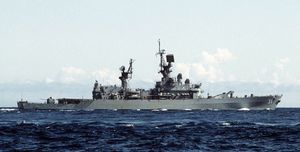
The NTDS equipped guided missile frigate USS Sterett (DLG 31) did her first stint of PIRAZ duty from 31-July 1968 to 5 August. She then moved to a different station in the Gulf of Tonkin serving as a sea air rescue ship, in which job Sterett directed rescues of two downed pilots. Following other assignments in Southeast Asia waters, the frigate was back on another PIRAZ station just off Bai Thuong, NV, in April 1970, this time in company with the guided missile cruiser USS Oklahoma City, a World War II six-inch gun cruiser converted to a Talos guided missile cruiser. In the conversion three of her four six-inch turrets had been removed, leaving one six-inch turret and one twin 5-inch gun mount, both forward. A Talos missile battery had been installed aft, but her conversion had been too early for the conversion to include the Naval Tactical Data System.
Usually a destroyer accompanied a PIRAZ ship to provide protection against motor torpedo boats, but this time Oklahoma City was Sterett’s ‘shotgun’ protection; and it was for a reason. Sterett’s Terrier missiles could reach out about 20 miles so, North Vietnamese aircraft normally stayed about 30 miles away from Terrier equipped ships, but the cruiser’s Talos missiles had a lethal range of more than 80 miles. The scheme was to lure North Vietnamese MiGs within range of the cruiser’s firepower, as Long Beach had done. The frigate and the cruiser were to steam so close together that they would look like one blip on the enemy’s radar, and the cruiser would not light off her search radars or any other radiating device that would give her away. Track coordinates of a victim airplane would be passed from Sterett to Oklahoma City using the frigate’s teletype-based NTDS link 14 that the cruiser could read. Other coordination would be done with encrypted secure voice radio. The missile trap probably would have worked very well, except there was no NV air activity in the area while the two ships were on station. [USS Sterett (CG-31), From Wikipedia, the free encyclopedia]
After a tour operating off the West coast of the U. S., Sterett was back in the Gulf of Tonkin on PIRAZ station in January 1972. This time, on 21 February 1962 her air intercept controllers directed a U. S. Air Force fighter in the destruction of a MiG-21, making the frigate the first USN ship to direct a USAF aircraft in the downing of an NV aircraft.
The North Vietnamese began an invasion of South Vietnam toward the end of March 1972; sending troops and tanks across the demilitarized zone between the two countries. In response, Oklahoma City with the two destroyers; Higbee (DD 806) and Lloyd Thomas (DD 764) were assigned to gun shore bombardment of the invading forces just off the NV coast near Dong Hoi. Even though Oklahoma City carried a Talos missile battery, Sterett was assigned to provide additional anti-aircraft cover with her Terrier system. The frigate also deployed her Light Airborne Multi Purpose System (LAMPS) helicopter to serve as an aerial spotter for the bombarding ships. Late in the afternoon the three gun ships began a bombarding run traveling parallel to the coast steaming toward the south. NV shore batteries began returning the fire and managed to ‘bracket’ the ships, but made no hits.
As the bombardment proceeded, a NV MiG-15 was detected among the coastal mountains heading for the bombarding ships. NV aircraft in the past had made feints toward U. S. forces afloat, but this one did not turn back; it bored in on Higbee. This would mark the first time NV aircraft had actually attacked U. S. fleet units. The MiG dropped a 250-pound bomb near the destroyer, but the near miss caused no damage. The persistent MiG circled back and this time scored a hit on Higbee’s after five-inch gun mount. The bomb blast, combined with exploding ready ammunition peeled the sides of the mount back like a sardine can. Fortunately the gun mount had just been vacated because one of the guns had a misfire of its powder case and the projectile in the hot barrel was in danger of ‘cooking off’ and exploding. Four men in the upper ammunition handling room below the mount were the only injuries.
In the mean time, Sterett had fired a Terrier missile at the attacking MiG, but missed. Her second Terrier did not miss. Soon after the MiG had started its attack, a second MiG, descending from the mountains, had started an attack but thought better of it and turned back toward the mountains. For a brief period, however, it was in range of Sterett's missiles and two missiles were loosed at it. The airplane and the two missiles all disappeared from the ships’ radars at the same time, and a second Sterett MiG kill was assumed.
The battle was not over yet though. As the four ships left the gun line heading northeast, Sterett’s NTDS surface tracker picked up two small surface targets heading at high speed toward the formation. The frigate locked her five-inch gun fire control radar on the nearest target and at the same time began making turns back and forth across the formation’s course to allow her forward mounted missile fire control radar to lock on to the same target. Suddenly, the fire control system operators noted that the missile fire control radar had lifted off the surface target and was tracking something in the air coming toward them. (The Terrier fire control system engagement logic was programmed so that if any new target appeared to separate upward from a surface target, it was to be assumed a missile had been fired at them and it would automatically lock on to the new air target.)
In a small compartment adjacent to the combat information center, Sterett’s electronic countermeasures operators saw that within seconds after target separation they detected a signal they identified as a Soviet-built SS-N-2 ‘Styx’ anti-ship missile homing radar. Sterett’s Terrier fire control system was already locked on to the suspected oncoming missile and it was a simple matter to quickly unleash two Terrier missiles at it. Sterett’s bridge watch saw the two missiles enter a cloud bank and seconds later heard the two missiles explode, although they never saw the actual impact. At the same time, the missiles and the target all disappeared from radar. They had every reason to believe they had killed a Styx missile. If so, they would be the first ship in history to down a guided missile with a guided missile. In the mean time, the frigate’s after five-inch gun had been working over the two oncoming surface targets, and they also disappeared from radar contact.
Sterett’s claimed Styx missile kill was the subject of much investigation and study. Analysts eventually concluded that if the frigate had shot down another air target it was most likely not a Styx. This is based primarily on the their belief that that the North Vietnamese did not at that time have an anti-ship missile. In his analysis of the Battle of Dong Hoi, analyst Stuart Slade concludes, “I think the USN had good reason to disallow the claimed shoot-down. This does not change the fact that the CIC crew did a fantastic job in a very confused environment. They had an air action to fight, a crippled ship to protect and also a potentially lethal surface threat developing. Even if they didn't kill a missile, they still deserve a salute for jobs well and skillfully done.” [Miller, Elden G., The Battle of Dong Hoi, originally published in the USS Sterett Association web site www.sterett.org] [Slade, Stuart, Analysis of the Battle of Dong Hoi, From web site www.navweaps. com]
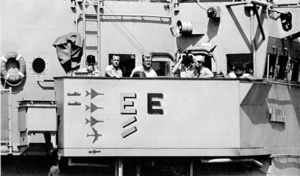
Elden G. Miller, author of The Battle of Dong Hoi was an NTDS data system technician aboard Sterett at the time of the engagement. He had the following observations about the NTDS fire control data converter that connected the NTDS computer with the Terrier missile system fire control computers. “An item of note is that at the time the fire control system on Sterett was not fully digital and any information passing between NTDS and the fire control system had to go through a device called the FCDC (fire control data converter). This was nothing more that banks of A to D and D to A converters. It was a bear to maintain since there were many tweaks and alignments needed of a regular (constant) basis. We had one DS by the name Michael Heuring who was placed in charge of this rack. It was his unsung efforts that allowed Sterett to pass fire control information from NTDS very accurately and allow that first Mig hit which was a straight ballistic shot bereft of the missile going live or actively homing. This shot was within the minimum range for the Terrier. The accuracy of the FCDC also was instrumental in the ship's ability to engage the purported missile intercept. On a side note, DS Heuring had the nickname of "Max Drift" and was a very detail oriented man...”
Don’t Fiddle With the Biddle
As of 18 July 1972 no North Vietnamese aircraft had attempted to attack a ship on PIRAZ duty, even though the ships were positioned only about 30 miles off their coast. This was probably due to their desire to avoid the ships’ surface-to-air missiles, not to mention the barrier combat air patrol (BARCAP) fighters always circling near the PIRAZ ship. This situation was about to change, however. USS Biddle (DLG 34), under the command of Capt. Edward W. Carter, was on PIRAZ station that night, and even though bad weather resulted in few U.S. flights over North Vietnam, Biddle’s CIC crew noted lots of NV air contacts. Sometimes Biddle was tracking up to 15 MiGs simultaneously, and they seemed to be practicing at a probable dive bombing range.
The following night, the 19th., started just as quietly. It was totally black outside with no moon and a high overcast. Again there was no U. S. air activity over North Vietnam except for the flight of one carrier based A-6 Intruder ground attack aircraft that had made a bombing run and was returning - damaged and copilot wounded. Commander Task Force 77 told one of the two BARCAP fighters to escort the damaged A-6 back to the carrier Midway. With half of the BARCAP gone, Lieutenant Ralph Muse, Biddle’s CIC Ship’s Combat Evaluator, radioed the Seventh Fleet command center aboard the carrier Kitty Hawk to ask that two ‘alert’ fighters be launched to fill in the gap. Seventh Feet replied back that the next flight of regular BARCAP fighters were to be launched within the hour, so the alert fighters would not be needed. The Seventh Fleet watch officer noted there was nothing gong on that night anyway. That left the Biddle CIC crew feeling a little more vulnerable to air attack, and heightened their lookout for suspicious air activity.
Most PIRAZ ships carried a detachment of U. S. Naval Security Group translators whose job was to constantly monitor NV voice radio communications and let the PIRAZ ship’s CIC crew and Seventh Fleet know what they were hearing. They were universally called ‘spooks.” Lt. Muse called the spooks and asked if they were hearing any unusual NV voice conversations. Their reply was, ‘check the area south of Hanoi on your radar.’ Muse told his ship’s weapons coordinator (SWC) to check the area and he immediately picked up two oncoming targets that could only be MiGs. They were over the water, moving fast, and headed straight for Biddle. While on PIRAZ duty, guided missile frigates normally had two Terrier missiles loaded on the launcher rails and ready to fire. Biddle was ready. Within seconds the SWC had the two Terrier radar directors locked on to the leading MiG.
The MiGs were in to less than nine miles, and a warning signal went off telling telling the CIC crew that the ship was being painted by MiG fire control radar. Lieutenant Muse passed the word on the ship’s general announcing system, “Captain to the CIC please,” but he knew he was going to have to take action before the CO could get there, and he definitely did not have the time to radio the Seventh Fleet watch officer to get permission to fire. He was going to have to “bet his bars” that they were MiGs, and fire the missiles. His next command was on the general announcing system, “Clear the Fo’c’sle” - where the Terrier launcher was located. Next commands were: “Fire One” and “Fire Two, ” after which he called for the ship’s general quarters alarm to be sounded.
Next, Muse ordered the launcher reloaded, and the fire control radars shifted to the second MiG. The launcher was ready again within thirty seconds, and by that time Capt. Carter had arrived in the CIC. Almost simultaneously the bridge watch saw an explosion on the horizon and the lead MiG disappeared from the radar. The missile kill apparently convinced the second MiG pilot it was pointless to continue the attack, and the eavesdropping spooks confirmed that the pilot had radioed his controller that he was returning to base.
About fifteen minutes after the second MiG had turned away, Biddle’s NTDS surface search operator called out that three targets were approaching Biddle ‘on the deck’ at 500 knots, and only seven miles out. Seconds later the operators of both air search radars detected the targets, and the lead target was assigned to a Terrier fire control radar. At the same time Capt. Carter radioed their escorting ‘shotgun’ destroyer, USS Gray, and told them they were relieved of motor torpedo boat protection duty, and to protect themselves from the MiGs. The MiGs were so low that the Terrier fire control radars were having difficulty getting lock on.
Capt. Carter ordered a turn so that the MiGs would be broadside on the port and ordered the five-inch gun mount at the stern and the port side three-inch gun amidships to fire at zero degrees elevation. It was called ‘barrage’ fire. Finally they got missile system radar lock and two more Terriers were fired at the close-in MiGs. There is some question whether they scored a hit, because by that time five-inch and three inch projectiles were exploding to port, triggered by their radar proximity fuses. The spooks called the CIC and told them one of the MiG pilots had radioed his controller that he had the ship on his fire control radar and was going to ‘kill’ it. The five-inch gun crew fired 54 rounds without pause until the cease fire was given. The three-inch gun fired an estimated 28 rounds before jamming.
It is possible the Terrier missiles accounted for one of the three MiGs and likely that a second MiG was brought down by barrage gun fire. In any event, all participants agree that the third MiG passed directly over the ship - but there was no explosion. One can only conjecture why. Possibilities are: a wounded pilot, a pilot distracted by intense gun fire, he was over the ship before he could react, or the bomb was a dud that landed nearby in the darkness but did not explode. Crewmen on the shotgun destroyer Gray told them that watching Biddle in action was like the fourth of July - with the huge flashes of missile launches, gun muzzles blazing, and projectiles exploding out over the water. For a complete account of Biddle’s ‘Battle at PIRAZ’ the reader is referred to James A. Treadway’s book Hard Charger! - The Story of the USS Biddle (DLG-34), published by iUniverse, Inc., New York, 2005, ISBN-13: 978-0-595-67313-1 [Author’s note, Jim Treadway was an NTDS data system technician aboard Biddle at the time of the Battle at PIRAZ.]
Vietnam Summary
The known USN ship surface-to-air missile engagements against NV aircraft have been recounted in the preceding section. In every case an NTDS ship was involved, but there were not a lot of missile engagements; most likely due to the NV pilots’ respect for the missiles and their desire to stay out of their way. The great majority of NV aircraft downings in which NTDS was involved were air intercepts. NTDS was used to direct thousands of intercepts. It is estimated that more than 90 percent of the intercepts were non-combat intercepts such as directing a fuel-low aircraft to an airborne tanker, vectoring a fighter out to identify an unknown air target, or directing search and rescue pilots to downed airmen. Less than ten percent were combat engagements, but there were still a lot.
It is beyond the scope of this article to go in to detail on NV aircraft shot down by fighters directed by NTDS air intercept controllers (AIC), but the case of one AIC is illustrative. Chief Operations Specialist Larry Nowell served aboard both the missile frigate Mahan and the missile cruiser Chicago while they were on PIRAZ station. During these operations he controlled more than 1,500 intercepts by Navy and Air Force fighters, of which more than 100 were live combat intercepts resulting in 13 NV aircraft kills. He was also credited for saving four USAF F-4 Phantom fighters, almost out of fuel, by expeditiously directing tanker airplanes to them. He was the first enlisted man in U. S. Navy history to be awarded the Distinguished Service Medal for combat action. [From Surface Navy Association web site, www.navysna.org/awards/halloffame]
So far we have talked about the impact of the Naval Tactical Data System on the individual ship; improving its tactical capability by giving it an automated combat information center. There was a much broader result of NTDS however. That was its ability to show all participating units the same tactical picture by virtue of the tactical data link. This also extended to the interacting Marine Tactical Data System and the Airborne Tactical Data System - which we have not yet talked about. When all levels of command could see the same tactical picture, down to the level of which ship or interceptor was engaging what target, and where they were; there was much less question asking as well as fewer attempts at micromanagement from higher command levels. They could delegate, and as long as things seemed to be going right they did not need to intervene. Once they had given their general orders, they could monitor the same picture that everybody else saw, and intervene only when something seemed to be going wrong, such as fighter in hot pursuit getting too close to the Chinese border. But normally the PIRAZ ship would have stepped in first anyway to warn the pilot. [Meyer, Radm. Wayne E., USN, p 116]
For a description of the use of NTDS in the 1990-1991 Desert Shield and Desert Storm conflicts the reader can click here to read Rear Admiral Thomas F. Marfiak's account.
A Pressing Need for More Memory
Fleet experience during the Vietnam War seemed to sell the forces afloat on NTDS. Suddenly the shoe was on the other foot; the fleet could see how the system worked and what it could do. And, they wanted it to do lots more things. The problem was the NTDS computers in every ship class were absolutely full. They all had some speed reserve, meaning they could do more things if they only had the memory. It became clear to the NTDS project office that a next generation of computer was needed. It should be faster, but above all, it had to have much greater memory capacity. It would take some time to develop a new computer, but even then, it would not be cost feasible to back fit them on existing NTDS ships. Some other approach was needed to increase memory capacity in existing systems. The first thought was to add at least one more computer to existing systems, but even this would take time, and the demand was for more memory -right now.
As a first stopgap measure, we hatched a scheme called dynamic module replacement (DMR), in which a computer could execute more functions almost at the same time. The scheme took advantage of the reality that in some situations various modules or subroutines in the computer program only had to be executed infrequently, or sometimes not at all for a long time. An example might be threat evaluation and weapons assignment - if the ship were in peacetime conditions, but was prosecuting a heavy air tracking load. In such a case track stores could be dynamically increased at the expense of deleting the TEWA module by rapidly loading a new air tracking module from magnetic tape. If the operators suddenly needed the TEWA function, it could be reloaded from tape at the press of a button. DMR would run under a set of priorities set by the CIC team who would decide the order of importance of the various functions depending on the tactical situation.
Dynamic module replacement programs were issued to the fleet in the mid 1960s, and in some situations they were found useful and gave the users more flexibility. But reloading program modules from magnetic tape was very slow compared with the speed at which computer programs could be executed. Even worse, constant use of the tape units wore out mechanical components prematurely. A better solution was needed, but one of the problems was that NTDS computer memories in the mid 1960s were made of small cast ferromagnetic/ceramic cores, and they were not cheap.
Experimenters had been trying various approaches to magnetic thin film memories, and even transistor based memories, but they had not yet devised a way to retain whatever was in the memory if the computer lost power. Retaining the contents of memory in the event of power failure was an absolute requirement of Navy tactical computers. In the event of power failure, tactical users could not tolerate the time lapse of reloading an entire computer’s memory from magnetic tape. Furthermore they needed to save track stores and all other data the computer had in memory when power was lost. They needed to be able to turn the computer back on and continue where they had left off. Magnetic core memory allowed them to do that because it always retained its last setting.
NTDS computer memory was a precious commodity to the programmers, and not to be wasted. Any time a new program module with significant mathematical operations was to be programmed, the NTDS project office required that it be programmed two ways, as a mathematical algorithm and a table look up scheme. Whatever approach consumed the least memory was the winner. In the early 60s core memory was also economically precious. This writer was assigned, for a year, to the Bureau of Ships Technical Representative (BSTR) office, the successor of the Naval Computing Machine Laboratory, at the Univac plant in St. Paul, MN. Univac engineers had ordered a shipment of magnetic cores for a CP-642 B computer and had asked that the box be delivered to the BSTR office since we were near the main gate. The box of cores arrived, in a paper bag, and we set it on a desk while we went to lunch. When we got back the paper bag was gone, and we assumed a Univac engineer had picked it up.
But shortly after, the engineer called and asked if the shipment was there. This did not sound too good. With a little detective work we found a cleaning crew had worked in the office while we were gone. A little more sleuthing revealed that the bag had been accidentally knocked into a waste basket, and that load of waste had already been dumped into the plant incinerator. The incinerator ashes were spread over a concrete floor, and sure enough there were small magnetic cores, about one sixteenth of an inch in outside diameter, mixed in with the ashes. The CP-642 B had 32,768 30-bit words in its memory, meaning, with spares, there were just about one million magnetic cores in the ashes. At ten cents per core, the ashes held about one hundred thousand dollars worth of cores.
We reasoned the cores were the result of a firing process, and the heat of the incinerator probably had not hurt them. Maybe it even made them better. A quick test of some of the cores picked from the ashes revealed the cores were as good as ever. We and a contingent of Univac engineers & technicians spent a fun filled day rescuing the cores from the ashes with long needles. The cores were strung into the machine’s memory planes, and it passed all performance and environmental tests with flying colors.
From the mid 1960’s the cost of magnetic core memory had a very satisfying drop, and the final solution for the original NTDS ships’ need for more memory was a device called the extended memory unit (ECMU). A new computer startup company in Minneapolis, named Control Data Corporation, won the Bureau’s industrywide competition to design and build the MU-602(V)/UYK extended memory unit. It turned out to be just about the same size as the unit computers, and contained more than 8 million magnetic cores, under the control of integrated circuit electronics. It had eight times the memory capacity of the CP-642 A and B unit computers, and its internal electronics, connected to a unit computer input/output channel, allowed unit computers to execute its programs as if the additional memory had been added directly to the unit computer.
Extended memory units were installed in 50 existing and new construction ships beginning in 1972. The very fast memory cycle time of the ECMU combined with the CP-642’s computing speed reserve markedly increased the ships tactical processing capability. Initial planning in the NTDS project had been to eventually back-fit older NTDS ships with new generation unit computers, but with the increased processing capability afforded by the extended memory units, almost all early NTDS ships kept their CP-642 computers to the end of ship’s life. [Control Data Corporation, Control Data MU-602(V)/UYK Extended Core Memory Unit, 1 Feb. 1975] [Control Data Corporation, Minneapolis Space and Defense Systems Division, Control Data Mass Memory Information Manual, Undated Publication 14077800, p 4] [Office of the Chief of Naval Operations, Letter to the Chief of Naval Material, Subject: Authority to Procure Solid State Extended Memory Devices (SSEM) Devices in Advance of Service Approval; request for, Serial OP-412F/ipl, Ser 757P41, 28 Apr. 1972]
We have mentioned, in passing, two other companion development projects to the Naval Tactical Data System: the Marine Tactical Data System and the Airborne Tactical Data System, and it is time to give them their due. By clicking on the this link the reader may proceed on to Chapter 8 of the Story of the Naval Tactical Data System.
